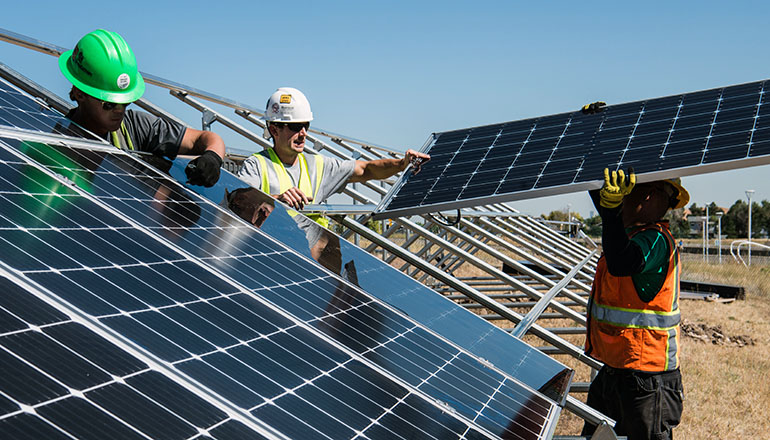U.S. Department of Agriculture Secretary Tom Vilsack announced that the Department is investing $464 million to build or improve renewable energy infrastructure and help rural communities, agricultural producers, and businesses lower energy costs in 48 states and Puerto Rico.
“USDA continues to prioritize climate-smart infrastructure to help rural America build back better, stronger and more equitably than ever before,” Vilsack said. “We recognize that lowering energy costs for small businesses and agricultural producers helps to expand economic development and employment opportunities for people in America’s rural towns and communities. The investments we are announcing today demonstrate how the Biden-Harris Administration has put rural communities at the heart of climate action and climate-smart solutions.”
USDA is financing $129 million of these investments through the Rural Energy for America Program. This program provides funding to help agricultural producers and rural small businesses purchase and install renewable energy systems and make energy efficiency improvements. These climate-smart investments will conserve and generate more than 379 million kilowatt-hours (kWh) in rural America, which equates to enough electricity to power 35,677 homes per year.
USDA is financing $335 million of these investments through the Electric Loan Program. The loans will help build or improve 1,432 miles of line to strengthen reliability in rural areas. The loans include $102 million for investments in smart grid technology, which uses digital communications to detect and react to local changes in electricity usage.
The department is announcing investments today in Alaska, Arizona, Arkansas, California, Colorado, Connecticut, Delaware, Florida, Georgia, Hawaii, Idaho, Iowa, Illinois, Indiana, Kansas, Kentucky, Louisiana, Massachusetts, Maryland, Maine, Michigan, Minnesota, Mississippi, Missouri, Montana, North Carolina, North Dakota, Nebraska, New Hampshire, New Jersey, New Mexico, New York, Ohio, Oklahoma, Oregon, Pennsylvania, Rhode Island, South Carolina, South Dakota, Tennessee, Texas, Utah, Virginia, Vermont, Washington, Wisconsin, West Virginia, Wyoming, and Puerto Rico.
For example:
- In North Dakota, Red Trail Energy LLC will use a $25 million loan to build a carbon-capture processing and storage facility at an ethanol manufacturing facility. The project will provide a 40 to 50 percent reduction in the carbon intensity score of ethanol the company produces. It also will enable the company to distribute ethanol to low-carbon fuel standard markets.
- Prairie State Solar, LLC will use a $95 million loan to construct a 99-megawatt solar photovoltaic farm on 621 acres in Perry County, Ill., about 50 miles southeast of St. Louis. Prairie State has a 27-year power purchase agreement with the Wabash Valley Power Association Inc. to sell and deliver the electricity produced. Wabash is an electric generation and transmission cooperative headquartered in Indianapolis. It provides wholesale power to 23 distribution cooperatives in Illinois, Indiana, and Missouri.
- Gulf Coast Solar LLC in Mississippi will use a $500,000 grant to improve energy efficiency at three wastewater treatment facilities in Hancock County. Funds will help the company design, build and install fixed-tilt, ground-mount solar photovoltaic equipment through a contract with LightEdison. The equipment will help replace 103 percent of the electricity at the North location, 57 percent of the electricity at the South location, and 107 percent of the electricity at the West location.
To learn more about these and other resources for rural areas, contact a USDA Rural Development state office.
Under the Biden-Harris Administration, Rural Development provides loans and grants to help expand economic opportunities, create jobs, and improve the quality of life for millions of Americans in rural areas. This assistance supports infrastructure improvements, business development; housing; community facilities such as schools, public safety, and health care; and high-speed internet access in rural, tribal, and high-poverty areas. For more information, visit the USDA Rural Development website. If you’d like to subscribe to USDA Rural Development updates, visit our subscriber page.
USDA touches the lives of all Americans each day in so many positive ways. In the Biden-Harris Administration, USDA is transforming America’s food system with a greater focus on more resilient local and regional food production, fairer markets for all producers, ensuring access to safe, healthy, and nutritious food in all communities, building new markets and streams of income for farmers and producers using climate-smart food and forestry practices, making historic investments in infrastructure and clean energy capabilities in rural America, and committing to equity across the Department by removing systemic barriers and building a workforce more representative of America. To learn more, visit the USDA website.
Photo by Science in HD on Unsplash







